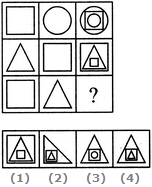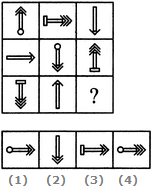Discussion
Home ‣ Non Verbal Reasoning ‣ Analogy See What Others Are Saying!
- Question
Select a suitable figure from the Answer Figures that would replace the question mark (?).
Problem Figures: Answer Figures: (A) (B) (C) (D) (1) (2) (3) (4) (5)
(A) (B) (C) (D) (1) (2) (3) (4) (5)
Options- A. 1
- B. 2
- C. 3
- D. 4
- E. 5
- Correct Answer
- 2
ExplanationIn the upper and the lower elements, the white part turns black and the black turns white. In the central arrow, one of the arrowheads from the LHS gets laterally inverted and moves to the RHS. - 1. If the mirror is placed on the line LM, then which of the answer figures is the right image of the given question figure?
Options- A. 1
- B. 2
- C. 3
- D. 4 Discuss
- 2. Find the question mark ? figure from answer figure.
Options- A. 1
- B. 2
- C. 3
- D. 4 Discuss
- 3. In this test the problem figure is of a wooden block. Think of the position which you will get when you place the block with its front side at the bottom.
Options- A. 1
- B. 2
- C. 3
- D. 4 Discuss
- 4. Select a figure from the given four alternatives which fits exactly into Figure-X to form a complete square.

Options- A. 1
- B. 2
- C. 3
- D. 4 Discuss
- 5. Select a suitable figure from the four alternatives that would complete the figure matrix.

Options- A. 1
- B. 2
- C. 3
- D. 4 Discuss
- 6. Find out the alternative figure which contains figure (X) as its part.
 (X) (1) (2) (3) (4)
(X) (1) (2) (3) (4)
Options- A. 1
- B. 2
- C. 3
- D. 4 Discuss
- 7. Select a suitable figure from the four alternatives that would complete the figure matrix.

Options- A. 1
- B. 2
- C. 3
- D. 4 Discuss
- 8. Select the alternative which represents three out of the five alternative figures which when fitted into each other would form a complete square.

Options- A. 145
- B. 234
- C. 134
- D. 235 Discuss
- 9. Choose a figure which would most closely resemble the unfolded form of Figure (Z).

Options- A. 1
- B. 2
- C. 3
- D. 4 Discuss
- 10. Choose a figure which would most closely resemble the unfolded form of Figure (Z).

Options- A. 1
- B. 2
- C. 3
- D. 4 Discuss
More questions
Correct Answer: 4
Explanation:
As we can see that the mirror image always be opposite to the original image across the given line. In water image upside becomes downside .
Correct Answer: 4
Explanation:
The inner design is enlarged and the outer design is reduced in size, and it becomes inverted and touches the enlarged inner design.
Correct Answer: 3
Explanation:
As per the given pattern in question figure , we can find the similar next position of given dice .
when you place the block with its front side at the bottom.Then we get similar to the Form ( 3 ).
Hence , required answer will be option C .
Correct Answer: 3
Explanation:

Correct Answer: 4
Explanation:
In each row, the second figure forms the innermost and the outermost elements of the third figure and the first figure forms the middle element of the third figure.
Correct Answer: 1
Explanation:

Correct Answer: 1
Explanation:
In each row, there are three types of arrows - an arrow with a single head and without any base, an arrow with double head having a circle at its base, an arrow with triple head having a rectangle at its base. Also, in each row, the arrows point in three directions - upwards, downwards and towards the right.
Correct Answer: 234
Explanation:

Correct Answer: 3
Correct Answer: 2
Comments
There are no comments.Programming
Copyright ©CuriousTab. All rights reserved.
